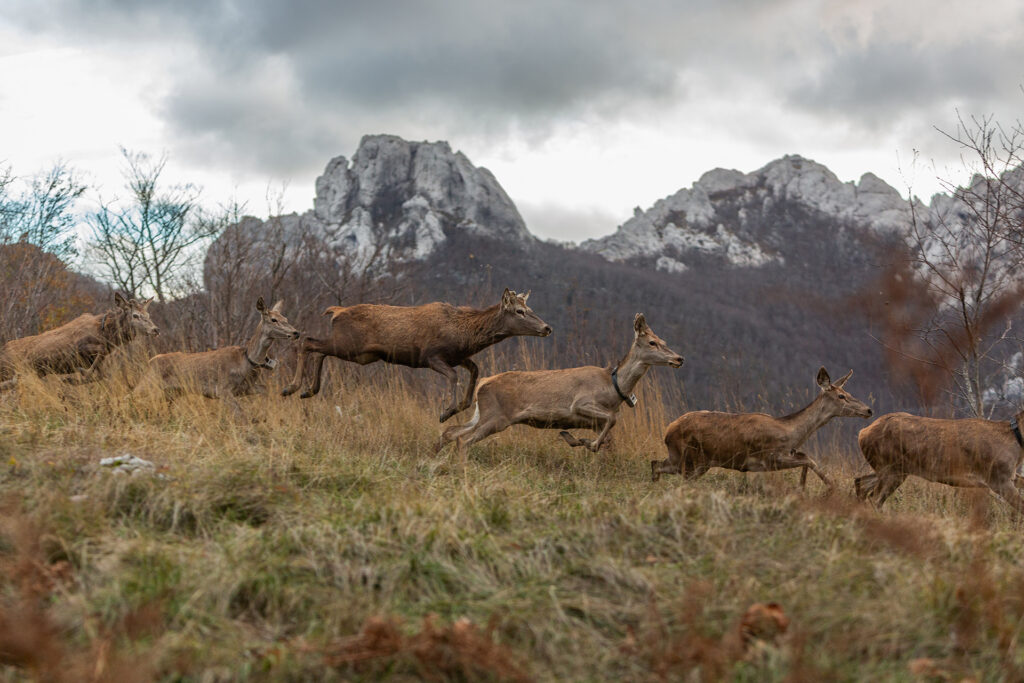A herd of 10 red deer have just been released in the Velebit Mountains rewilding landscape in Croatia. As part of an ongoing restocking programme, the release will help to restore the population across the landscape to a more healthy level, with benefits for wild nature and local communities.

Diverse benefits
A herd of 10 red deer (three males and seven females) have been released in the Velebit Mountains rewilding landscape in Croatia. Having been transported from northwest Croatia, the animals were set free by members of the Rewilding Velebit team in Dabarsko jezero, a site within the Crna duliba – Metla hunting concession, which is managed by the team. Strengthening the population of red deer already living in the area – which is far below its natural level a result of years of overhunting – the animals will help to restore local food webs and enhance natural grazing.
Wildlife comeback in the Velebit Mountains is also benefitting local communities. In partnership with Rewilding Velebit, Rewilding Europe’s work in the Velebit Mountains is focused on transforming the management of five hunting concessions totalling nearly 30,000 hectares.
As wildlife populations recover within these concessions, the aim is to transition away from traditional hunting operations to wildlife watching, with five newly constructed hides becoming operational in 2023. Enhancing the population of red deer in the landscape will support this transition; red deer are an attraction for wildlife enthusiasts and photographers in themselves, and also form an important prey base for other iconic Velebit wildlife species, such as wolves, Eurasian lynx, bears, and griffon vultures.
Hunting legacy
There is a long tradition of hunting in Croatia and the Velebit Mountains. Its legacy in the rewilding landscape and beyond can be seen in the relatively low abundance of species such as red deer and chamois.
“Apart from wild boar, and perhaps bears, the numbers of all wildlife species across Velebit are too low – from roe deer and red deer to chamois and capercaillie,” says Rewilding Velebit Communications Officer Kruno Bošnjaković.

Long-term population enhancement
The Rewilding Velebit team have been releasing herds of red deer in various sites within the Velebit Mountains rewilding landscape since 2016. Including the latest release, 50 animals have now been set free, with more releases planned for next year. Populations will be allowed to breed naturally, protected by a temporary ban on the hunting of red deer and roe deer in one of the concessions managed by the Rewilding Velebit team.

“Our plan is to assess the situation next year after wildlife monitoring has been carried out, and then to release additional animals,” explains Rewilding Velebit team leader Marija Krnjajić. “To begin with, an initial assessment of abundance and distribution of priority species within the rewilding landscape is essential. In the longer term, we are applying a rigorous monitoring framework to measure the ecological impact of the rewilding process and the return of wildlife as a result of reduced hunting pressure.”
A number of deer released by the Rewilding Velebit team have been fitted with GPS collars. This will give the team insight into seasonal migration and habitat use, and should help to improve wildlife management across the landscape.
Want to know more?
- Rewilding Velebit
- Watch Emmanuel Rondeau’s documentary on rewilding in the Velebit Mountains
- Velebit Mountains Annual Review story: “From guns to cameras“
